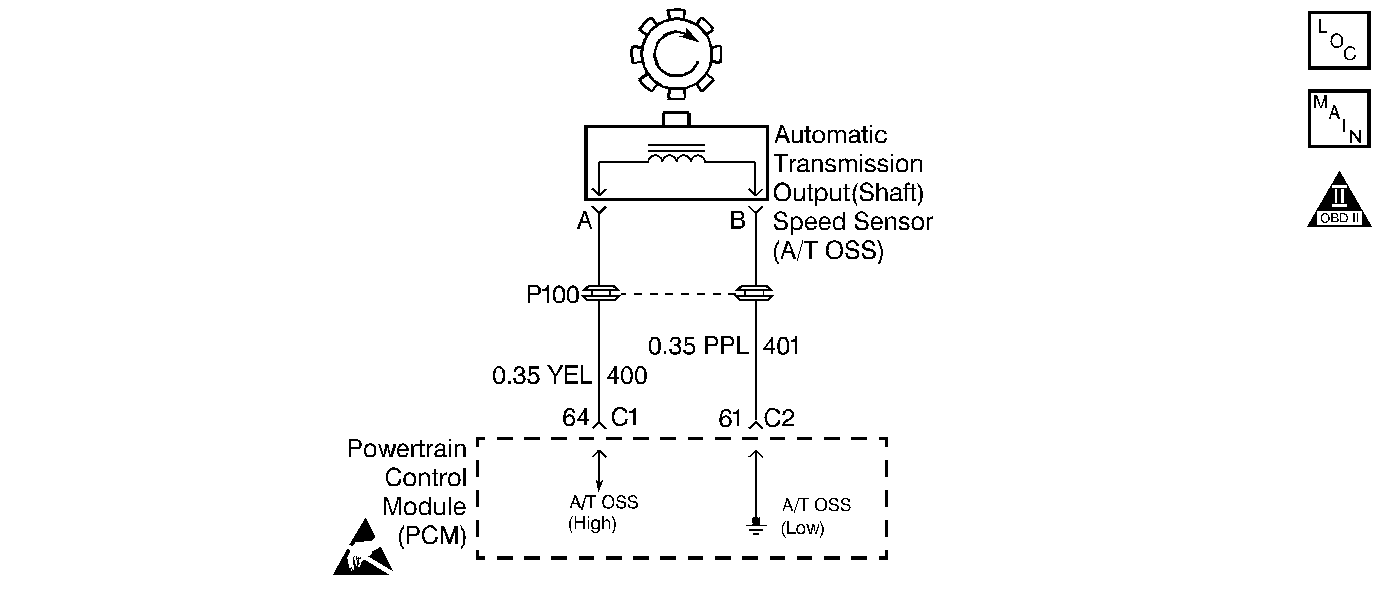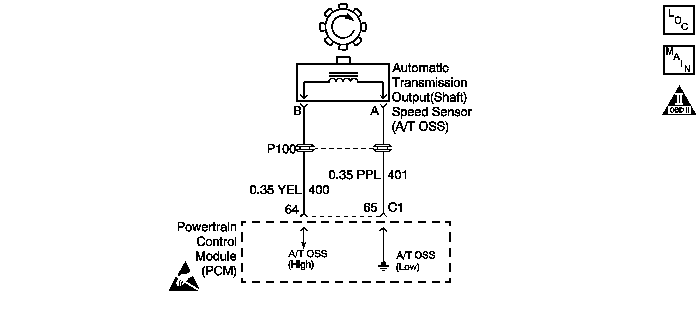DTC P0503 Vehicle Speed Sensor (VSS) Circuit Intermittent 2.4L

Circuit Description
The Automatic Transmission Output (Shaft) Speed Sensor (A/T OSS) provides vehicle speed information to the Powertrain Control Module (PCM). The A/T OSS is a Permanent Magnet (PM) generator mounted to the transmission case. The PM generator produces an AC voltage as the transmission speed sensor rotor teeth pass through the sensor's magnetic field. The AC voltage level increases as the speed of the vehicle increases. The PCM converts the AC voltage into a digital signal. The PCM uses the vehicle speed signal to determine shift timing, Torque Converter Clutch (TCC) apply, TCC release, and gear ratio calculations.
When the PCM detects a loss of vehicle speed while the vehicle is in motion, then DTC P0503 sets. DTC P0503 is a type B DTC.
Conditions for Setting the DTC
| • | No TFP Val. Position Sw. DTC P1810 |
| • | The engine is running. |
| • | The time since the gear select lever change is greater than 6 seconds. |
| • | Output speed drops more than 1,200 RPM within 4 seconds. |
Action Taken When the DTC Sets
| • | The PCM illuminates the Malfunction Indicator Lamp (MIL). |
| • | The PCM commands maximum line pressure. |
| • | The PCM freezes shift adapts from being updated. |
| • | The PCM calculates output speed from input speed, engine speed, and commanded gear. |
| • | DTC P0503 is stored in the PCM history. |
Conditions for Clearing the MIL/DTC
| • | The PCM turns OFF the MIL after three consecutive trips without a failure reported. |
| • | A scan tool can clear the DTC from the PCM history. The PCM clears the DTC from the PCM history if the vehicle completes 40 warm-up cycles without a failure reported. |
| • | The PCM cancels the DTC default actions when the fault no longer exists and the ignition is OFF long enough in order to power down the PCM. |
Diagnostic Aids
| • | The condition may be intermittent. Inspect for a loose A/T OSS, or poor sensor connection. |
| • | Inspect the wiring at the PCM and at the A/T OSS 2-way connector for the following conditions: |
| - | A bent terminal |
| - | A backed out terminal |
| - | A damaged terminal |
| - | Poor terminal tension |
| - | A chafed wire |
| - | A broken wire inside the insulation |
| - | Moisture intrusion |
| - | Corrosion |
| • | When diagnosing for an intermittent short or open condition, massage the wiring harness while watching the test equipment for a change. |
| • | Inspect for a damaged A/T OSS. Inspect for damaged transmission rotor teeth. |
Test Description
The numbers below refer to the step numbers on the diagnostic table.
-
This step tests the ability of the A/T OSS to produce an AC current. This step also verifies the integrity of the wiring to the PCM.
-
This step tests the A/T OSS circuit for correct resistance.
Step | Action | Value(s) | Yes | No | ||||||||||
|---|---|---|---|---|---|---|---|---|---|---|---|---|---|---|
1 | Were you sent here from the Powertrain On-Board Diagnostic (OBD) System Check? | -- | ||||||||||||
2 |
Important: Before clearing the DTCs, use the scan tool to record the Freeze Frame and Failure Records for reference. Using the Clear Info function will erase the stored Freeze Frame and Failure Records from the PCM. Notice: Support the lower control arms in the normal horizontal position in order to avoid damage to the drive axles. Do not operate the vehicle in gear with the wheels hanging down at full travel. With the drive wheels rotating, does the transmission output speed increase when the wheel speed increases? | -- | Go to Diagnostic Aids | |||||||||||
Can a voltage greater than the specified value be obtained? | 0.5 V AC | |||||||||||||
Select ohms on the DMM in order to measure circuit resistance. Is the circuit resistance within the specified range? | 1,530 - 1,870 ohms | |||||||||||||
5 | Is the circuit resistance greater than the specified value? | 1,870 ohms | ||||||||||||
6 |
Is the circuit resistance less than the specified value? | 1,530 ohms | ||||||||||||
7 | Inspect circuits 400 and 401 for being shorted together. Refer to General Electrical Diagnosis . Did you find and correct the condition? | -- | -- | |||||||||||
8 | Inspect circuit 400 for short to ground. Refer to General Electrical Diagnosis . Did you find and correct the condition? | -- | ||||||||||||
9 |
Does the DMM display system voltage? | -- | ||||||||||||
10 | Inspect circuit 400 for a short to voltage. Refer to General Electrical Diagnosis . Did you find and correct the condition? | -- | -- | |||||||||||
11 |
Refer to General Electrical Diagnosis . Did you find and correct the condition? | -- | ||||||||||||
12 |
Refer to Unit Repair. Is the repair or replacement complete? | -- | -- | |||||||||||
13 | Replace the A/T OSS. Refer to Vehicle Speed Sensor Replacement . Is the replacement complete? | -- | -- | |||||||||||
14 | Replace the PCM. Refer to Powertrain Control Module Replacement/Programming . Is the replacement complete? | -- | -- | |||||||||||
15 | In order to verify your repair, perform the following procedure:
Has the test run and passed? | -- | System OK |
DTC P0503 Vehicle Speed Sensor (VSS) Circuit Intermittent 3.1L

Circuit Description
The Automatic Transmission Output (Shaft) Speed Sensor (A/T OSS) provides vehicle speed information to the Powertrain Control Module (PCM). The A/T OSS is a Permanent Magnet (PM) generator mounted to the transmission case. The PM generator produces an AC voltage as the transmission speed sensor rotor teeth pass through the sensor's magnetic field. The AC voltage level increases as the speed of the vehicle increases. The PCM converts the AC voltage into a digital signal. The PCM uses the vehicle speed signal to determine shift timing, Torque Converter Clutch (TCC) apply, TCC release, and gear ratio calculations.
When the PCM detects a loss of vehicle speed while the vehicle is in motion, then DTC P0503 sets. DTC P0503 is a type B DTC.
Conditions for Setting the DTC
| • | No TFP Val. Position Sw. DTC P1810. |
| • | The engine is running. |
| • | The time since the gear select lever change is greater than 6 seconds. |
| • | Output speed is greater than 500 RPM. |
| • | Output speed drops more than 1,200 RPM within 3 seconds. |
Action Taken When the DTC Sets
| • | The PCM illuminates the Malfunction Indicator Lamp (MIL). |
| • | The PCM commands maximum line pressure. |
| • | The PCM freezes shift adapts from being updated. |
| • | The PCM calculates output speed from input speed, engine speed, and commanded gear. |
| • | DTC P0503 is stored in the PCM history. |
Conditions for Clearing the MIL/DTC
| • | The PCM turns OFF the MIL after three consecutive trips without a failure reported. |
| • | A scan tool can clear the DTC from the PCM history. The PCM clears the DTC from the PCM history if the vehicle completes 40 warm-up cycles without a failure reported. |
| • | The PCM cancels the DTC default actions when the fault no longer exists and the ignition is OFF long enough in order to power down the PCM. |
Diagnostic Aids
| • | The condition may be intermittent. Inspect for a loose A/T OSS, or poor sensor connection. |
| • | Inspect the wiring at the PCM and at the A/T OSS 2-way connector for the following conditions: |
| - | A bent terminal |
| - | A backed out terminal |
| - | A damaged terminal |
| - | Poor terminal tension |
| - | A chafed wire |
| - | A broken wire inside the insulation |
| - | Moisture intrusion |
| - | Corrosion |
| • | When diagnosing for an intermittent short or open condition, massage the wiring harness while watching the test equipment for a change. |
| • | Inspect for a damaged A/T OSS. Inspect for damaged transmission rotor teeth. |
Test Description
The numbers below refer to the step numbers on the diagnostic table.
-
This step tests the ability of the A/T OSS to produce an AC current. This step also verifies the integrity of the wiring to the PCM.
-
This step tests the A/T OSS circuit for correct resistance.
Step | Action | Value(s) | Yes | No | ||||||||||
|---|---|---|---|---|---|---|---|---|---|---|---|---|---|---|
1 | Were you sent here from the Powertrain On-Board Diagnostic (OBD) System Check? | -- | ||||||||||||
2 |
Important: Before clearing the DTCs, use the scan tool to record the Freeze Frame and Failure Records for reference. Using the Clear Info function will erase the stored Freeze Frame and Failure Records from the PCM. Notice: Support the lower control arms in the normal horizontal position in order to avoid damage to the drive axles. Do not operate the vehicle in gear with the wheels hanging down at full travel. With the drive wheels rotating, does the transmission output speed increase when the wheel speed increases? | -- | Go to Diagnostic Aids | |||||||||||
Can a voltage greater than the specified value be obtained? | 0.5 V AC | |||||||||||||
Select ohms on the DMM in order to measure circuit resistance. Is the circuit resistance within the specified range? | 1,530 - 1,870 ohms | |||||||||||||
5 | Is the circuit resistance greater than the specified value? | 1,870 ohms | ||||||||||||
6 |
Is the circuit resistance less than the specified value? | 1,530 ohms | ||||||||||||
7 | Inspect circuits 400 and 401 for being shorted together. Refer to General Electrical Diagnosis . Did you find and correct the condition? | -- | -- | |||||||||||
8 | Inspect circuit 400 for short to ground. Refer to General Electrical Diagnosis . Did you find and correct the condition? | -- | ||||||||||||
9 |
Does the DMM display system voltage? | -- | ||||||||||||
10 | Inspect circuit 400 for a short to voltage. Refer to General Electrical Diagnosis . Did you find and correct the condition? | -- | -- | |||||||||||
11 |
Refer to General Electrical Diagnosis . Did you find and correct the condition? | -- | ||||||||||||
12 |
Refer to Unit Repair. Is the repair or replacement complete? | -- | -- | |||||||||||
13 | Replace the A/T OSS. Refer to Vehicle Speed Sensor Replacement . Is the replacement complete? | -- | -- | |||||||||||
14 | Replace the PCM. Refer to Powertrain Control Module Replacement/Programming . Is the replacement complete? | -- | -- | |||||||||||
15 | In order to verify your repair, perform the following procedure:
Has the test run and passed? | -- | System OK |
